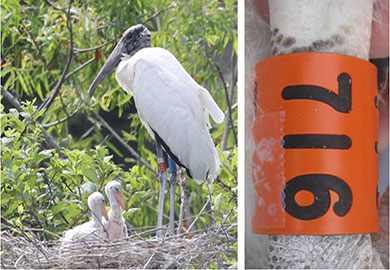DNR News
** Archived Article - please check for current information. **
August 15, 2014
DNR asks public to report sightings of banded wood storks
During 2014, the S.C. Department of Natural Resources (DNR) banded 100 wood stork chicks with field-readable bands. The bands used in South Carolina are orange with black numbers. Several other color combinations are being used for other projects. Researchers throughout the southeast are banding storks as part of a collaborative project to learn more about their movements, demography, and longevity.
The banded chicks have fledged (learned to fly) and are dispersing as they search for food. Young storks are vulnerable to starvation as they are learning to feed efficiently, so it is particularly important not to disturb groups of wading birds that are feeding in impoundments during the fall. Please do not disturb birds to read band codes.
Please report any sightings of banded wading birds to the S.C. Department of Natural Resources (DNR) at wadingbirds@dnr.sc.gov and also to the Bird Banding Lab or 1-800-327-BAND. DNR often can provide information about where and when the bird was banded.
Satellite transmitters are also being used by researchers to answer a variety of management questions about wood storks. Nine wood storks were outfitted with transmitters at the Washo Reserve in South Carolina last year. You can learn about their travels on the Wildlife Tracking website.
If you see wood storks, you can check to see if they have bands by looking at their upper legs. Some storks have multiple bands, but typically only one of the bands has a code made up of numbers and/or letters. If you see a banded stork, you can contribute to this project by recording the following information: 1) color of band, 2) color of engraved code, 3) code, 4) location of band on stork – which leg, 5) color and location of any additional bands or transmitter on stork, 6) location where stork is located.
In addition to the storks that nest in South Carolina, many storks that nest in other states visit South Carolina during the fall to feed. Storks are regularly seen throughout the lowcountry, sometimes in large groups. Storks are also occasionally seen farther inland. For more information about storks and other wading birds in South Carolina, please see the DNR Wading Bird website.
More News
- August is Tree Stand Safety Awareness month
- Aiken County wildlife area opens to the public Saturdays in September
- Import of deer, elk parts into SC still limited by state regulation
- DNR asks public to report sightings of banded wood storks
- Fifty fields available for public dove hunting
- Banded mourning doves provide vital information to biologists
- Abbeville County youth dove hunt to be held Sept. 6
- State wildlife, fisheries group meets Aug. 21 in Columbia
- Dove hunting opportunity expanded for SC hunters
- Volunteer instructors sought for new Family Fishing Clinics
- Upstate National Hunting and Fishing Day set Sept. 20 at Duke Energy's World of Energy
- Early-season migratory bird seasons approved by S.C. Natural Resources Board
- Deer hunts for mobility impaired hunters to be held in Upstate
- Conservation Bank to host Land Trusts workshop Sept. 23 in Columbia
- Freshwater fishing trends
- Saltwater fishing trends
- S.C. weekly tidetable
- DNR video
- Archived news releases
